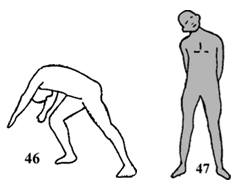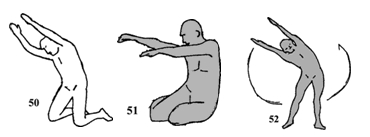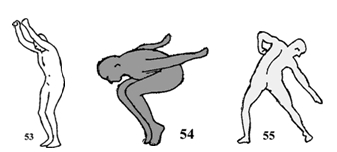Course XVIII - Teaching 5: Preparatory Exercises III and IV
Preparatory Exercises III
25) Lateral position. Wide position, parallel feet and arms raised high up. Rotate and bend your trunk downwards to left, by bending at the same time the left knee, while breathing out. Go back to the initial position while breathing in, and repeat to right (Figure number 46).
Breathing out. Respiratory exercise number 5.
26) Lateral position. Hands joined on the back with fingers entwined and hand palms joined. Rotate your head to right and left with elastic insistence. Meanwhile do not retain breath (Figure number 47).
Later, in an easier position, rotate in the same way your head, but with a strong initial drive, and relax immediately neck muscles. Three times each.
Neck relaxation. Relaxation exercise number 25 c.

- Sitting down on the ground. Leg joined and stretched.. Arms at both sides with elbows bent and fits clenched. Trace circles with your elbows to make shoulders more flexible, while you keep the trunk erect. Later, lead elbows backwards and rather upwards, first slowly and later quickly. This stretches neck muscles.
- At attention (or natural) position. Join hands on the back of the neck, and also leaned on a wall or a chair. Drive one leg forward and backward. Keep the trunk erect, or incline it lightly with drive in the same direction. Six times each.
- Natural (or at attention) position. Raise one thigh until the horizontal line. Slowly trace wide circles with the knee while you let the leg hang vertically. Later tap your thighs with the knuckles. Thigh relaxation through hip drive. Relaxation exercise number 13.
- Laterally lying down. One leg over the other; the hand of the arm that is below, with its palm on the ground near the shoulder. Stretch this arm and raise this way your trunk laterally. In this position, straighten the whole body while raising the hip too. In this position, raise the leg upward, bend it or trace circles with it. Shake arms (Figures numbers 48 and 49).
Breath for heart recovery, lying down face upwards.

- Knelt on the ground. Knees somewhat apart, and thighs in vertical position. Your arms high up shall trace the form of a funnel through light rotation of the trunk from the hip. Four times each (Figure number 50).
- Natural (or at attention) position. Bend your wrist downwards, upwards and to left, while you hold the forearm with the other hand and watch closely the movement. Later, trace circles with the hand from the wrist, and shake it.
Relaxed arm falls. Relaxation exercise number 2. - Lateral position. Parallel feet. Jump in squatting with legs together, and hands leaned on knees. From this position, jump again to the lateral position, and help yourself by pressing your hands on the knees. Repeat elastically several times. This stretches extensors of legs. Shake your legs. Six-eight times.
Great breath in with full breathing out.
Leg relaxation through sliding. Relaxation exercise number 16. - Lateral position. Raise your body on tiptoe. Jump with crossed legs and alter continuously their position while keeping the breath normal. This gives strength, endurance and speed to calf muscles. Breath for heart recovery.
- Knelt on the ground. Approach thighs to heels. Sit down on the ground to right and left of your heels. Later do the same, with arms stretched forward, with simultaneous trunk rotation inwards. Also practice this with drive. 4-6 times (Figure number 51).
- Passage position. In this position, try to increase the distance between both feet. It stretches flexors and extensors of legs.

Preparatory Exercises IV
- Lateral position. Arms stretched high up. Rotation of trunk to right and left, by tracing a wide circle, producing the movement of hip flexion, and keeping the front position of the trunk. Three times each. Breath for heart recovery (Figure number 52).
- Natural position. Stretch arms forward, somewhat over the horizontal line, and clench your fists. Bend knees by driving them and at the same time stand on tiptoe with drive of arms backwards. Knees must look forward. Later shake legs. 4-6 times (Figures 53 and 54).
Breathing out. Respiratory exercise number 5.
Thigh relaxation through hip drive. Relaxation exercise number 13. - Lateral position. Arms at both sides of the body while your clasp your fists. Bend slowly, laterally the trunk toward the right side, while at the same time you bend the left knee and lean the left arms in such a way that the left fist can be attracted to the left armpit. Your right arm remains more or less parallel with the right leg. Do not bend the trunk forward. Do the same with left leg. Two times each (Figure number 55).
- Lateral position. Arms stretched at both sides. Drive both arms straightforward and cross them in front of your chest. Do not bend elbows at any moment. This stretches muscles of the back. Four times.
- Natural (or at attention) position. Arms hanging freely, raise one leg forward with strong drive. Let your leg raise stretched as high as possible. Keep your support leg straight, also on tiptoe, and trunk vertically, in its widest angle. This stretches buttock muscles and leg flexors. Later, do the same to both sides. Later do the same, but with hands on the back of the neck, arms at both sides or forward (Figure number 56). Breathing out. Respiratory exercise number 5.
Relaxed leg through sliding. Relaxation exercise number 16. - Knelt on the ground. Sitting down on one’s heels. Incline trunk backwards, as much as possible, in such a way that your head touches the ground, while you raise lightly both arms forward. This stretches abdominal muscles and leg extensors. Shake your legs. Three times (Figure number 57).
Thigh relaxed through sliding. Relaxation exercise number 14.

- Lateral position. Arms stretched at both sides in natural or at attention position. While you breathe in, lead arms backwards with the intention of raising them a little at the same time, but do not yield on the area of your head. After the greatest muscular tension in shoulders and back, your arms go back to their initial position.
Later, while stressing the above-mentioned muscles, you can make little arcs upwards and downwards with both arms. Trace circles with your shoulders while you let your harms hang freely downwards. - Natural position. Arms stretched forward. Lower to squatting position, the sole of the foot on the ground, with elastic insistence. Later, shake your legs (Figure number 58).
Chest breath. Respiratory exercise number 1.
Thigh relaxed through hip drive. Relaxation exercise number 13.

- Knelt on the ground. Also hands leaned on the ground. (Crawling position). Advance a little forward your support on hands. Bend both arms while you keep forearms vertical, in such a way that shoulders remain at a lower level than elbows. Now, straighten a little both arms, while at the same time you push the trunk backwards; keep it very low and breathe in. Later, push the trunk forward, beneath the level of elbows, while you breathe out. Repeat several times with continuous pendulum movement. This exercise produces a better stretching of the whole front area of the trunk, excellent straightening of vertebral column, and the widest respiratory possibility. Compare with exercise number 22, –Somewhat Difficult–(Figure number 59).
Breath for heart recovery, lying down face upwards.
- Natural position. Raise one leg stretched, and lean its heel on the edge of a table. Bend freely the trunk forward with elastic insistence. Both legs as much stretched as possible. This exercise stretches buttock muscles and leg extensors.
Leg relaxed through fall. Relaxation exercise number 15.
- Lateral position. Join both hands at the back, interlacing fingers and palms of the hands together. Incline your head to one side, keeping your chin high, with elastic insistence. Later, rotate your leg to right, holding your head from behind with your left hand in such a way that you help your head to overpass certain limit. Do the same to the other side. Three times each.
Neck relaxed. Relaxation exercise number 25 a. - Sitting down on the ground. Both legs must be stretched and quite apart. Hands on the back of the neck or hanging freely. Bend the trunk over left leg, later over right leg, and finally forward on the ground. Also do the same holding heels with both hands. Sit down and get up from the ground several times as quickly as possible. Breath for heart recovery, lying down face upwards (Figure number 60).